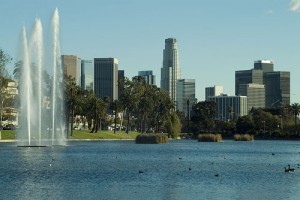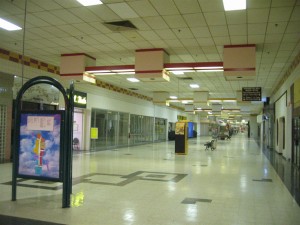Posted: August 5th, 2010 | Author: jenny | Filed under: Uncategorized | 3 Comments »
One of the tools we can use to assess housing prices in a specific area is the income to home price ratio. Generally, median disposable household income should be able to support the median home price.  Disposable income is gross income minus current taxes.  The traditionally sound formula for assessing whether a particular home is affordable is that the home should not exceed two and a half to three times the buyer’s household income. Certain metropolitan areas can be more expensive and the ratio might run a bit wider. Where I live in Los Angeles, for example, we have historically seen a ratio closer to three and a half times annual income.
From time to time I like to take a look at home pricing in a particular neighborhood in the Los Angeles area. A couple of months ago I examined the situation in Burbank in my post LA Housing Is Still Too Expensive .  At the request of Xtine from the blog Flip City I have now run the numbers for Echo Park.
 Echo Park is an older Los Angeles neighborhood just northwest of the downtown area. By older, I mean largely built up in the 1920s and ’30s. It was initially the bedroom community of the silent film industry and later became a predominantly working class Latino community. It has always been known for its artists and bohemian culture. Echo Park has seen a lot of gentrification over the last fifteen years or so, which really picked up during the housing bubble years with all the excess faux wealth floating around. Prices skyrocketed during this time and it is now unaffordable to most prospective buyers. But is this justified? Let’s take a look.
Echo Park is an older Los Angeles neighborhood just northwest of the downtown area. By older, I mean largely built up in the 1920s and ’30s. It was initially the bedroom community of the silent film industry and later became a predominantly working class Latino community. It has always been known for its artists and bohemian culture. Echo Park has seen a lot of gentrification over the last fifteen years or so, which really picked up during the housing bubble years with all the excess faux wealth floating around. Prices skyrocketed during this time and it is now unaffordable to most prospective buyers. But is this justified? Let’s take a look.
 The annual median household income in Echo Park is around $36,000 as of 2008, with close to a third of households living under the poverty line. I was not able to find newer statistics regarding income, but I don’t imagine it has risen over the past two years. Given the 12%-plus unemployment rate in California and continuing budget cuts and furloughs, I think we can assume this number has not grown much, if at all.
The annual median household income in Echo Park is around $36,000 as of 2008, with close to a third of households living under the poverty line. I was not able to find newer statistics regarding income, but I don’t imagine it has risen over the past two years. Given the 12%-plus unemployment rate in California and continuing budget cuts and furloughs, I think we can assume this number has not grown much, if at all.
The median selling price of a single family residence in Echo park from April through June of this year was $374,000. This is far below the lofty median of $680,000 we saw at the bubble’s peak, but still up $79,000 from last year. I imagine the latest bounce was due largely to buyers rushing to get in on the federal tax credit that came to an end during that period, thereby creating a temporary surge in demand.  If we look at the market without the stimulus of the tax credit we can estimate the median selling price would be around $300,000.
 So, let’s examine the income to home price ratio and see where Echo Park stands in its current valuation. If we take the statistics at face value we can see that with an annual household income of $36,000 in the area the median home price, at three times that, would be justified somewhere in the area of $108,000. If we consider that this is historically a somewhat more expensive area and run the figure at four times the annual household income we can see the median priced home should be running around $145,000.  Note that I am using gross income statistics here, not the reduced disposable income figures which would really afford less than that.
So, let’s examine the income to home price ratio and see where Echo Park stands in its current valuation. If we take the statistics at face value we can see that with an annual household income of $36,000 in the area the median home price, at three times that, would be justified somewhere in the area of $108,000. If we consider that this is historically a somewhat more expensive area and run the figure at four times the annual household income we can see the median priced home should be running around $145,000.  Note that I am using gross income statistics here, not the reduced disposable income figures which would really afford less than that.
So in the very best case scenario for home price valuation we are looking at an ideal median price of $145,000 for Echo Park, but the actual home price median is running at $374,000!  That’s ten times the median gross income of the town’s residents.  Even if you adjust for the stimulus of the expired tax credit and suppose prices will return to $300,000, you are still looking at overvaluation of more than fifty percent. So we can conclude that prices in Echo Park are still much too high. There is room for home prices in Echo Park to drop by at least half.
Echo Park Income Statistics:
citydata.com
http://www.city-data.com
Echo Park Home Prices:
Trulia Real Estate Search
http://www.trulia.com
Posted: August 1st, 2010 | Author: jenny | Filed under: Uncategorized | 2 Comments »
I’m afraid all the research I did for my last post on the threat of economic depression left me a bit… well, depressed. Economic downturn, PMS and the compulsive mind a bitter cocktail mix. So I have been searching for a quiet spot in the din ever since, and perhaps even one of those elusive green shoots we heard so much about not so long ago. What has come to mind is something I read over a year ago in The Huffington Post. The article was about the California Institute of the Arts and featured the words of the school’s president Steven Levine. Apparently, he is optimistic about the collapse of the economy because he believes it will be good for the arts.
“When you can’t define yourself any longer by what you can buy, you suddenly have to look deeper for what life is about and I think that gives an opening for the arts that it hasn’t had before, an opening for it to matter again,” he explained.
Lavine’s words stayed with me because I’d been having the same thought. I see the potential for deep individual and communal growth to come out of all the loss at hand, a redefining of who we are and what is important to us.  I do not mean to diminish the gravity of the situation, as I know for many the consequences of economic loss have been and will continue to be dire. But having a background in the arts makes me look to the power of the salve it offers, as I imagine the comfort will be welcome in treating the wounds we are left with.  Beyond that, art is the exercise of creativity, and creativity will provide solutions.
 I remember on a trip to the Los Angeles County Museum of Art as a child I came across a statue portraying the Hindu God Shiva as Nataraja, “The Lord of Dance.” He danced in a circle of fire with his hair flowing out behind him on either side and legs and arms bent in motion. I was struck by the form and the symbolism.
I remember on a trip to the Los Angeles County Museum of Art as a child I came across a statue portraying the Hindu God Shiva as Nataraja, “The Lord of Dance.” He danced in a circle of fire with his hair flowing out behind him on either side and legs and arms bent in motion. I was struck by the form and the symbolism.
You may know the image, as it is a popular portrayal of Shiva. In his upper right hand he holds a drum, on which he creates language with each beat becoming a syllable. In his upper left hand he holds a vessel of fire which gives the power to destroy. Shiva’s dance is one of destruction in order to prepare for creation; it is a symbol of the cycle which gives rise to both forces and binds them inextricably together. That which is no longer stable and useful must be cleared to make room for new growth. A third hand is held in a gesture of fearlessness. This gesture assures us of the stability of the world. And herein lies an important idea. Shiva remains serene and upright in the midst of the whirling battle that surrounds him. There is a profound balance maintained as the forces of creation and destruction converge in their fiery cycle.
 If we look closely at Shiva’s hair we see the currents of the mighty river’s flow, with Ganga the river goddess moving through his winding locks. This refers to the story of her descent to earth. In the myth it is necessary for her to come to wash the earth and purify the ashes of the dead, but her descent from heaven threatens to destroy the whole world. Because of one man’s piety and commitment, Shiva agrees to break the fall of the river goddess, and the flood crashes into his hair before splashing safely to earth. Ganga’s great river purifies all in its path and the earth is reborn.
If we look closely at Shiva’s hair we see the currents of the mighty river’s flow, with Ganga the river goddess moving through his winding locks. This refers to the story of her descent to earth. In the myth it is necessary for her to come to wash the earth and purify the ashes of the dead, but her descent from heaven threatens to destroy the whole world. Because of one man’s piety and commitment, Shiva agrees to break the fall of the river goddess, and the flood crashes into his hair before splashing safely to earth. Ganga’s great river purifies all in its path and the earth is reborn.
Here The Paper Boat finds itself tripping along the ripples of sacred waters. We enter a time of great destruction, but amidst the chaos an opening emerges. A clearing grows. We find ourselves facing the dilemma opportunity presents. There is space developing for something new. What will it be? What do we paint upon the blank canvas? Nature abhors a vacuum. Something will be built. If we embrace the challenge there is opportunity for evolution here. Creativity is the key.
“Drifting
On a sea of forgotten teardrops
On a lifeboat
Sailing for your love
Sailing home”
– Jimi Hendrix
The Huffington Post
Culture Zohn: Cal Arts: The Wild West is Alive
Patricia Zohn
May 8, 2009
http://www.huffingtonpost.com
Posted: July 28th, 2010 | Author: jenny | Filed under: Uncategorized | No Comments »
Last month Nobel Prize winning economist Paul Krugman of the NY Times put forth a dire warning that we are in the beginnings of a third depression. There have been two already in US history, the Long Depression that followed the Panic of 1873 and the Great Depression of the early 20th Century.

“We are now, I fear, in the early stages of a third depression. It will probably look more like the Long Depression than the much more severe Great Depression. But the cost — to the world economy and, above all, to the millions of lives blighted by the absence of jobs — will nonetheless be immense,” Krugman writes.
Most agree it was a failure of economic policy that brought us to this point. However, the proposed solutions differ greatly among various economists and business leaders. Krugman’s Keynesian approach would be to increase stimulus spending, but critics argue that this approach has been ineffective so far and warn against the consequences of driving deficits to even more precarious heights than where they now stand.
“In the last two years, we’ve had gargantuan spending and ultra-easy money,” says CNBC host Larry Kudlow in an interview with CEO Steve Forbes of Forbes magazine, “which is what Professor Krugman has been advocating the whole time. And he still thinks we’re in a depression. So I need to ask you, maybe his policies are what threaten the depression.”
“Well, it’s like the old physicians who continue to bleed the patient and wonder why the patient isn’t getting better and then bleeds the patient even more,” Forbes responds. “What we should be doing, yes, we should be cutting back spending because it takes money from productive citizens.”
Fiscal conservationists (a.k.a. “deficit hawks” to those who side with Krugman on this issue) maintain the US national debt is already at a tipping point and taking on further debt would threaten to push the country itself into bankruptcy. They also point out that the consumer is tapped out between personal debt, diminished credit and unemployment, and simply cannot afford to pay higher taxes or subsidize further bailout programs.
Liberal economist and co-director of the Center for Economic and Policy Research in Washington D.C., Dean Baker, sides with Krugman. He likens the stimulus effort to trying to put out a forest fire with only a few buckets of water. He explains it’s not working because we need more water.
“I mean we lost over a trillion dollars a year in annual demand. We tried to replace it with the stimulus that it came to from the federal sector about $300 billion a year, you subtract out the cuts at the state and local level, that’s $150 billion a year. Where I come from $150 billion isn’t going to make up a loss of a trillion. That’s simple arithmetic.”
As the debate rages on about how to deal with the fiscal crisis in which we find ourselves, more and more economists seem to agree that difficult times lie ahead. We may even be heading into a real depression. In a recent interview with Charlie Rose, NYU economist Nouriel Roubini warned of a looming global crisis. He now says a double dip in the recession has already arrived.
“Fasten your seat belts for a very bumpy ride.† At best, Roubini says, “we face a protracted period of anemic, below-trend growth in advanced economies as deleveraging by households, financial institutions, and governments starts to feed through to consumption and investment.â€
On the extreme end, market forecaster and social theorist Robert Prechter of Eliott Wave International is convinced we are headed for a crisis worse than any we’ve seen yet, with the possibility of the Dow falling below 1000. His analysis is based on principles developed by Ralph Nelson Elliott in the 1930’s, which assert that financial markets move according to complex but predictable fractal patterns based on cycles of social mood among investors.
“I’m saying: ‘Winter is coming. Buy a coat,’†Prechter forecasts. “Other people are advising people to stay naked. If I’m wrong, you’re not hurt. If they’re wrong, you’re dead. It’s pretty benign advice to opt for safety for a while.â€
At the close of the G20 conference in Toronto last month US policy makers seemed to be turning away from the idea of employing further stimulus at this time and toward adopting a plan of greater fiscal austerity and balanced-budget orthodoxy, as the Euro zone has done with verve as of late. Hence, Krugman’s lament.
“And who will pay the price for this triumph of orthodoxy?” he asks. The answer is, tens of millions of unemployed workers, many of whom will go jobless for years, and some of whom will never work again.”
Wherever we may go from here, the fact is we are already experiencing unemployment at depression levels according to the U6 measurement, which accounts for those who are underemployed and those who have given up looking for work out of despair, as well as those who are unemployed and receiving benefits. And there is no visible source of job creation on the horizon. What lies ahead instead is a further rise in unemployment, larger budget deficits, continuing decline in home prices, larger losses for banks, shrinking access to credit and possible protectionist measures that will dampen growth. Depression is upon us.
New York Times
The Third Depression
Paul Krugman
6/27/2010
http://www.nytimes.com
NewsBusters
Kudlow, Forbes Debunk Krugman’s “Third Depression” Call
Jeff Poor
6/29/2010
http://newsbusters.org
New York Times
A Market Forecast That Says “Take Cover”
Jeff Sommer
7/2/2010
http://www.nytimes.com
Moneynews.com
Robini: Don’t Fear A Double Dip, It’s Already Here
Julie Crawshaw
7/22/10
http://www.moneynews.com
Posted: July 22nd, 2010 | Author: jenny | Filed under: Uncategorized | No Comments »
According to analysis from New York based real estate research firm Reis Inc, vacancies at US neighborhood shopping centers moved closer to the highest on record during the second quarter of this year. This contributes to evidence that the economic recovery has not taken hold amongst the people despite what you might read in the press. Consumers are tapped out with the highest debt levels in history and plummeting credit scores. Malls are becoming ghost towns. Consumer sentiment is eroding and frugal attitudes are most likely here to stay for a long time. Forget about consumer sentiment, no one’s got any money to spend and now there are fewer places to spend it.
 Because of the wealth concentrated where I live in Los Angeles we are not seeing the devastation to shopping centers that some other areas are, but I noticed recently on a trip to a local mall that the  wide selection of goods we grew accustomed to during the boom years has greatly deteriorated.  On this particular occasion I was looking at costume jewelry specifically, trying to find a simple long silver-tone chain necklace. I thought I’d have twenty to choose from at Macy’s alone. No such luck! They had two, and neither was long enough. (My goodness, what’s a girl to do?) I wandered from store to store and finally came across something I could use after three hours of searching. The good news for me is it had been marked down to half price- cause no one’s buying out there! At the same time I’ve noticed the selection of specialty housewares and luxury items explode over the last couple of years at second run retailers like Marshall’s and Ross. Heated slippers and olive tongs are just not viable in today’s recessionary market, I suppose.
Because of the wealth concentrated where I live in Los Angeles we are not seeing the devastation to shopping centers that some other areas are, but I noticed recently on a trip to a local mall that the  wide selection of goods we grew accustomed to during the boom years has greatly deteriorated.  On this particular occasion I was looking at costume jewelry specifically, trying to find a simple long silver-tone chain necklace. I thought I’d have twenty to choose from at Macy’s alone. No such luck! They had two, and neither was long enough. (My goodness, what’s a girl to do?) I wandered from store to store and finally came across something I could use after three hours of searching. The good news for me is it had been marked down to half price- cause no one’s buying out there! At the same time I’ve noticed the selection of specialty housewares and luxury items explode over the last couple of years at second run retailers like Marshall’s and Ross. Heated slippers and olive tongs are just not viable in today’s recessionary market, I suppose.
Expect to see more economic damage to shopping centers. People are moving toward frugality (it’s the new black!). This is as much out of necessity as it is out of a growing distaste for frivolous consumption and addictive spending. Heck, we may even have a real depression in the works here after all. In any case, it seems the party of a lifetime is long over and we find ourselves coming to in some sort of an abandoned shopping center with a splitting headache and an empty wallet.
Bloomberg Businessweek
U.S. Shopping Center Vacancies Approach Record High, Reis Says
Hui-yong Yu
July 7, 2010
http://www.bloomberg.com/
 Echo Park is an older Los Angeles neighborhood just northwest of the downtown area. By older, I mean largely built up in the 1920s and ’30s. It was initially the bedroom community of the silent film industry and later became a predominantly working class Latino community. It has always been known for its artists and bohemian culture. Echo Park has seen a lot of gentrification over the last fifteen years or so, which really picked up during the housing bubble years with all the excess faux wealth floating around. Prices skyrocketed during this time and it is now unaffordable to most prospective buyers. But is this justified? Let’s take a look.
Echo Park is an older Los Angeles neighborhood just northwest of the downtown area. By older, I mean largely built up in the 1920s and ’30s. It was initially the bedroom community of the silent film industry and later became a predominantly working class Latino community. It has always been known for its artists and bohemian culture. Echo Park has seen a lot of gentrification over the last fifteen years or so, which really picked up during the housing bubble years with all the excess faux wealth floating around. Prices skyrocketed during this time and it is now unaffordable to most prospective buyers. But is this justified? Let’s take a look. The annual median household income in Echo Park is around $36,000 as of 2008, with close to a third of households living under the poverty line. I was not able to find newer statistics regarding income, but I don’t imagine it has risen over the past two years. Given the 12%-plus unemployment rate in California and continuing budget cuts and furloughs, I think we can assume this number has not grown much, if at all.
The annual median household income in Echo Park is around $36,000 as of 2008, with close to a third of households living under the poverty line. I was not able to find newer statistics regarding income, but I don’t imagine it has risen over the past two years. Given the 12%-plus unemployment rate in California and continuing budget cuts and furloughs, I think we can assume this number has not grown much, if at all. So, let’s examine the income to home price ratio and see where Echo Park stands in its current valuation. If we take the statistics at face value we can see that with an annual household income of $36,000 in the area the median home price, at three times that, would be justified somewhere in the area of $108,000. If we consider that this is historically a somewhat more expensive area and run the figure at four times the annual household income we can see the median priced home should be running around $145,000.  Note that I am using gross income statistics here, not the reduced disposable income figures which would really afford less than that.
So, let’s examine the income to home price ratio and see where Echo Park stands in its current valuation. If we take the statistics at face value we can see that with an annual household income of $36,000 in the area the median home price, at three times that, would be justified somewhere in the area of $108,000. If we consider that this is historically a somewhat more expensive area and run the figure at four times the annual household income we can see the median priced home should be running around $145,000.  Note that I am using gross income statistics here, not the reduced disposable income figures which would really afford less than that.


